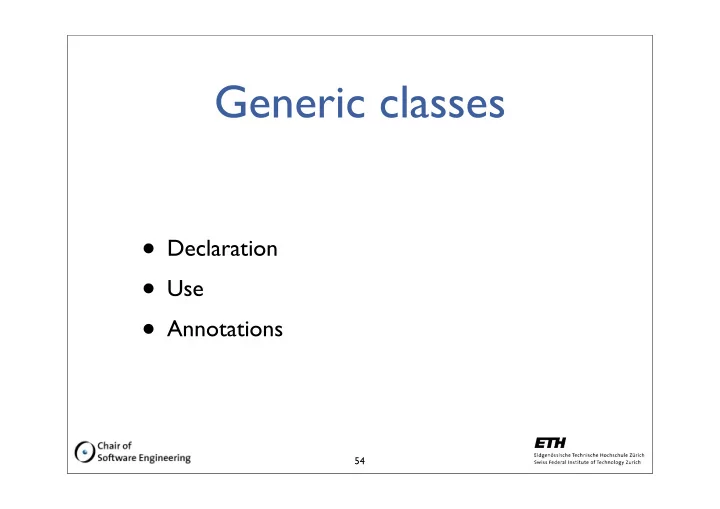

Generic classes • Declaration • Use • Annotations 54
Generic classes Declaration • add generic types between angle brackets: public class MyStack < E,F >{ E item; } 55
Generic Classes Use MyStack<Integer> ms= new MyStack<Integer>(); 56
Generic Classes Annotations • public int count(MyClass<?> mc){...} • public int count(MyClass<? extends String> mc){...} • public int count(MyClass<? extends String & Countable> mc){...} 57
Why not subtype generics MyStack<Integer> myStack=new MyStack<Integer>(); public static void add(Stack<Object> st, Object o){ st.add(o); } 58
Example: MySmallStack public void add(E value){ Element<E> e; e= new Element<E>(value); e.next=this.first; this.first=e; } ... MySmallStack<Integer> myStack = new MySmallStack<Integer>(); myStack.add(1); 59
Nested Classes • Classes that are declared in a file, along another one • If outside a class: static • If inside, it depends... they can be inner classes 60
Inner Classes • A particular type of nested classes • Anonymous • Method-scope • Class scope 61
Anonymous Inner Classes • Declared at instanciation public void wave(){ Object o = new Object(){ public Object clone(){ return this; } }; ... } 62
Method Inner classes • declared in a method • visible only in the method // method declaration public void wave(){ class Hello2 extends HelloWorld{ }; ... } 63
Class Inner Classes • Declared in the class • visibility decides on access control outside of the class public class HelloWorld extends Object{ class Hello2 extends HelloWorld{ }; // method declaration public void wave(){ ... } } ... HelloWorld.Hello2 h=new HelloWorld.Hello2(); 64
Some interesting classes • Object • String • System • Vector 65
Object • See API 66
String • See API 67
System • See APIs 68
Vector • See APIs 69
Java Basics Part 3 - Exceptions Manuel Oriol, April 13th, 2006
Throwable • The Throwable interface is meant to represent computational events that can interrupt the current computation • Computation can occur after the event is handled 71
Exception • Exceptions represent events that are meant to be treated. • Whenever a method may trigger an exception, it is required that it declares so (modulo conformance). Except for RuntimeExceptions. 72
Runtime Exceptions AnnotationTypeMismatchException, ArithmeticException, ArrayStoreException, BufferOverflowException, BufferUnderflowException, CannotRedoException, CannotUndoException, ClassCastException, CMMException, ConcurrentModificationException, DOMException, EmptyStackException, EnumConstantNotPresentException, EventException, IllegalArgumentException, IllegalMonitorStateException, IllegalPathStateException, IllegalStateException, ImagingOpException, IncompleteAnnotationException, IndexOutOfBoundsException, JMRuntimeException, LSException, MalformedParameterizedTypeException, MissingResourceException, NegativeArraySizeException, NoSuchElementException, NullPointerException, ProfileDataException, ProviderException, RasterFormatException, RejectedExecutionException, SecurityException, SystemException, TypeNotPresentException, UndeclaredThrowableException, UnmodifiableSetException, UnsupportedOperationException ... 73
Error • Meant to represent an unrecoverable error • Can be recovered still... • Example: AnnotationFormatError, AssertionError, AWTError, CoderMalfunctionError, FactoryConfigurationError, LinkageError, ThreadDeath, TransformerFactoryConfigurationError, VirtualMachineError 74
Throw, throws • it is possible to throw an exception manually by using: throw an_exception ; • methods that may fail due to an exception (non-runtime) have to indicate it: public void m() throws MyException{...} 75
try...catch... finally try{ ... } catch ( MyException1 e ){...} catch ( MyException2 e ){...} ... finally{...} 76
Recommend
More recommend